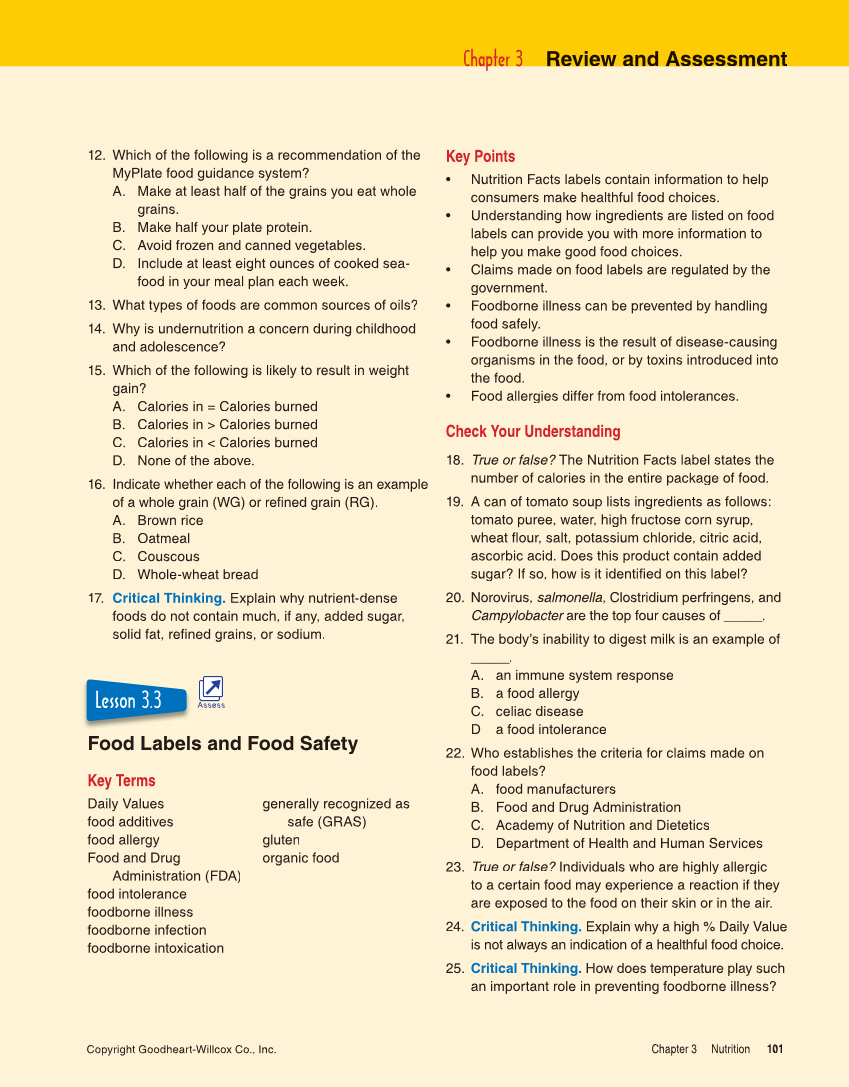Copyright Goodheart-Willcox Co., Inc. Chapter 3 Nutrition 101 12. Which of the following is a recommendation of the MyPlate food guidance system? A. Make at least half of the grains you eat whole grains. B. Make half your plate protein. C. Avoid frozen and canned vegetables. D. Include at least eight ounces of cooked sea- food in your meal plan each week. 13. What types of foods are common sources of oils? 14. Why is undernutrition a concern during childhood and adolescence? 15. Which of the following is likely to result in weight gain? A. Calories in = Calories burned B. Calories in Calories burned C. Calories in Calories burned D. None of the above. 16. Indicate whether each of the following is an example of a whole grain (WG) or refi grain (RG). fined A. Brown rice B. Oatmeal C. Couscous D. Whole-wheat bread 17. Critical Thinking. Explain why nutrient-dense foods do not contain much, if any, added sugar, solid fat, refi ned grains, or sodium. Food Labels and Food Safety Key Terms Daily Values food additives food allergy Food and Drug Administration (FDA) food intolerance foodborne illness foodborne infection foodborne intoxication generally recognized as safe (GRAS) gluten organic food Chapter 3 e a Re e view a nd d Assess ssess me e nt t Lesson 3.3 Key Points • Nutrition Facts labels contain information to help consumers make healthful food choices. • Understanding how ingredients are listed on food labels can provide you with more information to help you make good food choices. • Claims made on food labels are regulated by the government. • Foodborne illness can be prevented by handling food safely. • Foodborne illness is the result of disease-causing organisms in the food, or by toxins introduced into the food. • Food allergies differ from food intolerances. Check Your Understanding 18. True or false? The Nutrition Facts label states the ? number of calories in the entire package of food. 19. A can of tomato soup lists ingredients as follows: tomato puree, water, high fructose corn syrup, wheat fl our, salt, potassium chloride, citric acid, ascorbic acid. Does this product contain added sugar? If so, how is it identified on this label? 20. Norovirus, salmonella, Clostridium perfringens, and Campylobacter are the top four causes of _____. r 21. The body’s inability to digest milk is an example of _____. A. an immune system response B. a food allergy C. celiac disease D a food intolerance 22. Who establishes the criteria for claims made on food labels? A. food manufacturers B. Food and Drug Administration C. Academy of Nutrition and Dietetics D. Department of Health and Human Services 23. True or false? Individuals who are highly allergic ? to a certain food may experience a reaction if they are exposed to the food on their skin or in the air. 24. Critical Thinking. Explain why a high % Daily Value is not always an indication of a healthful food choice. 25. Critical Thinking. How does temperature play such an important role in preventing foodborne illness? Assess
